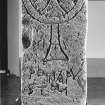Following the launch of trove.scot in February 2025 we are now planning the retiral of some of our webservices. Canmore will be switched off on 24th June 2025. Information about the closure can be found on the HES website: Retiral of HES web services | Historic Environment Scotland
Whithorn, Bruce Street, Museum, Petrus Stone
Cross Slab (Early Medieval), Inscribed Stone (Period Unknown)
Site Name Whithorn, Bruce Street, Museum, Petrus Stone
Classification Cross Slab (Early Medieval), Inscribed Stone (Period Unknown)
Canmore ID 121882
Site Number NX44SW 56.02
NGR NX 4449 4028
Datum OSGB36 - NGR
Permalink http://canmore.org.uk/site/121882
- Council Dumfries And Galloway
- Parish Whithorn
- Former Region Dumfries And Galloway
- Former District Wigtown
- Former County Wigtownshire
NX44SW 56.02 4449 4028
(2) Squared stone pillar with cross and inscription. The stone formerly stood by the side of the road south of Whithorn.
On the front is incised a cross with curved expanded arms set within a double circle; the cross is formed of four segments of circles which intersect near the centre of the enclosing circle. The right hand line of the top arms of the cross serves as the upright of a capital R. The cross and circle are set on a small stem with a flatbase and curved sides. On the stem is cut a capital T; to the right is a short curved line, possibly the bungled setting out of the stem. To the left of the stem and occupying the full width of the stone below it is cut in three lines:
LOCI/PETRI APU/STOLI
(The place of Peter the Apostle.)
The letters are straggling and uneven with forked serifs and the uprights of the P and R rising above the top of the loops. This type of letter belongs to Merovingian Gaul, where it went out of fashion during the 8th century; it is very rare in the British Isles.
A locus is a place, possibly a cemetery, with perhaps a small oratory, dedicated to God in honour of a saint. The phrase and the use of the Gaulish alphabet suggest Celtic rather than Saxon connections. A date in the 7th century is indicated.
Radford and Donaldson 1953b, 39.












